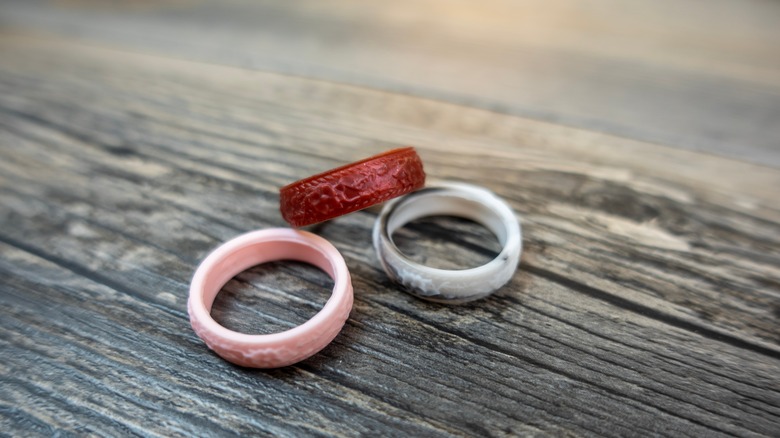Should You Wear Your Engagement And Wedding Ring While Working Out?
Getting engaged or married is something to be excited about — so it's not surprising if you find yourself wanting to show off your new status as a fiancée by flashing your diamond ring in the group chat, or wanting to wear it as often as possible so you can admire it all day long.
While rings are exchanged with the intention of "forever," that isn't always literal when it comes to how long the symbolic jewelry has to stay on your finger. As much as you might love and value your ring, both in aesthetic and sentimentality, the reality is that there are definite times in which it's in your best interest not to wear it. Though jewelry isn't always realistic for those who live active lifestyles to regularly wear, some may still choose to wear an engagement and/or wedding ring as a symbolic representation of their partnership. This prompts many to wonder whether or not it's a good idea to wear it to the gym or while working out at home. Unfortunately, it's not a good idea to wear your engagement ring while you exercise, but don't worry — there are other kinds of rings you can wear to the gym!
Working out while wearing your ring can cause injury
Working out, particularly when it involves lifting weights or operating any other form of gym equipment or machinery, can lead to your ring getting caught on something. This is what's known as ring avulsion, which occurs when a ring on your finger is suddenly ripped away from you, per Cleveland Clinic. While ring avulsions don't happen often, they can often lead to blood clots, damaged tendons, and even the amputation of the injured finger. A ring is more likely to get caught on something if there's ample space between the metal and your finger, making it all the more important to take your ring off before hitting the gym if you have yet to get it sized.
Lifting weights also leaves you susceptible to crushed fingers, which can lead to swelling and cut off the circulation in your finger if you are unable to remove your ring. To avoid having to have your ring cut off in the event of an emergency, or risk permanently injuring your finger, it's best to just leave the jewelry at home.
Working out can damage your ring
According to Hingham Jewelers, the most common engagement and wedding ring materials, such as gold, sterling silver, and platinum, are easily malleable, and are therefore easily able to be bent by the force of weight machines and dumbbells. Bending or altering the structure of your engagement or wedding ring in any way compromises the integrity of the ring as whole, as the diamonds and other stones are specifically designed to be held in place by a perfectly circular band. Once your band is no longer circular, your stones are likely to start falling out, which often isn't noticed until long after the fact. This can make them impossible to find, especially if you don't know when or where they came free.
The sweat that comes with working out can also do a number on your ring. In particular, it can eat away at your band's rhodium-plated finish, which is what gives your white gold jewelry its shiny appearance.
Consider a silicone ring instead
If you are a gym rat but tend to forget to remove your ring or don't like going long periods without it, you might want to consider one made of silicone as opposed to a traditional metal one. Though they aren't as flashy or as traditional as a diamond, many people who live active lifestyles find themselves preferring the low-stakes commitment that comes with a silicone ring. Those who wear silicone rings find that they enjoy the simplicity they provide and find it more convenient to wear all the time. But you might also choose to just swap your usual diamond ring out for a rubber one when you know you have a super active day ahead, or if you plan on an upper body session at the gym.
Unlike a metal ring, a silicone ring is designed to be bendy and flexible, allowing it to provide a lot of give in the event it gets snagged. The rubbery material absorbs the blow and protects your finger from any potential trauma (via Enso Rings). A silicone ring can also easily break should it get caught on anything, freeing your hand and fingers in the event of an emergency.



